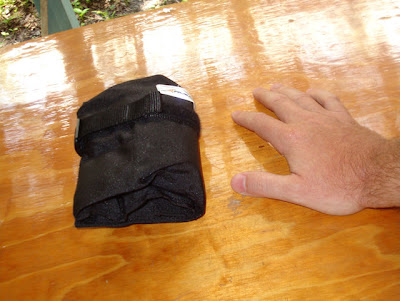Posted on 8/26. :(. QUITE delayed... I had other tasks that I made a higher priorities, which stretched into... Oh, I have SO much catching-up to do on my blog! Again making it more of a monumental task! Now I'm beginning to play catch-up. The calendar on the right below is always updated pretty quickly, because it is a much easier task to do!
 The front wheel of my hog, revealing some of the temporary repair
The front wheel of my hog, revealing some of the temporary repairOn with my hog (recumbent tricycle) repair. First, I had to remove the front wheel from my hog. Next, I had to remove the tire from the wheel. As I removed the tire, I also pulled out any of the tie-downs that I used for the temporary fix. The tie-downs themselves had a center core of metal wire surrounded by a red foam tube with yellow plastic end caps that were intended to hold each tie-down together.
The excessive wear and tear of being used pseudo-inner tube broke off most of these plastic caps which wore away some if the inside of the tire. Luckily, the tire itself was not punctured as a few of the ties' inner wires were extending quite a bit from the red foam tubes. The wires, broken caps, and remnants from the worn inside of the tire can be seen in the picture below.
The old inner tube was beyond repair because of its long punctures (exacerbated by my riding on it and turning) before I had to institute the temporary repair at Northern Tool. I still used it as both a tube protector (I used it as an extra layer of rubber in between the new tube and the tire) and to patch the spoke guard (upcoming). I know that you can't wait to hear about it! :)
 Various inner tubes, and the temp fix
Various inner tubes, and the temp fixIs that baby powder in the picture above? Why, yes it is! The baby (talcum) powder is used as a dry lubricant to help install the new inner tube and to allow the tube to seat properly. It helps to partially inflate the new tube as well to ease both applying a coating of talcum powder, and inserting the new tube into the tire.
 The bare wheel sitting on my shed workbench
The bare wheel sitting on my shed workbenchUpon inspecting the wheel's rim, there was a small dent (ding) in it before inserting the new tube, to any damage from it. I'm sure the ding occurred from hitting that break in the sidewalk that caused this whole incident. This ding was on the seam of the rim, which is a weak point. I straightened the ding with pliers and then sanded the rim, so that it was smooth on its outer and inner edges.
 The bare wheel sitting on my shed workbench
The bare wheel sitting on my shed workbenchThe next step in this seemingly endless repair (it only took a good part of a day), was to address the tube protector/spoke guard. This is like a giant rubber band that protects the inner tube from any sharp edges on the spoke nuts. The spoke nuts look like screws from inside the rim, but their threads are internal, like a nut. The ends of the spokes actually have mating external threads, so can loosen or tighten each spoke to "true" (straighten) the wheel. I noticed that the tube guard was about to snap apart while I repaired the rim ding. The tube protector was rubber, I was able to patch where it was about to break apart with a piece of rubber trimmed from the old, punctured inner tube. The patch on it worked well!
After that, I reassembled everything. I installed the repaired wheel, the tire, and the new inner tube. Done!
 My hog repaired, the time on this picture was 7:07PM!
My hog repaired, the time on this picture was 7:07PM!The repair was completed on Thursday, July 8th. It was my goal to have it fixed by the following day, so I could take it for ride...











